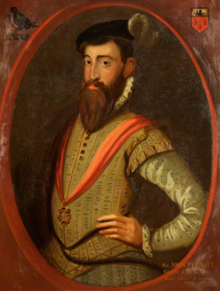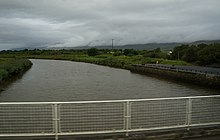
The Knight of Glin, also known as the Black Knight or Knight of the Valley, was a hereditary title held by the FitzGerald and FitzMaurice families of County Limerick, Ireland, since the early 14th century. The family was a branch of the FitzMaurice/FitzGerald Dynasty commonly known as the Geraldines and related to the now extinct Earls of Desmond who were granted extensive lands in County Limerick by the Crown. The title was named after the village of Glin, near the Knight's lands. The Knight of Glin was properly addressed as "Knight".
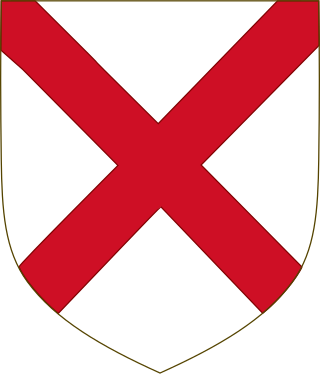
The FitzGerald dynasty is a noble and aristocratic dynasty of Cambro-Norman and Anglo-Norman origin. They have been peers of Ireland since at least the 13th century, and are described in the Annals of the Four Masters as having become "more Irish than the Irish themselves" or Gaels, due to assimilation with the native Gaelic aristocratic and popular culture. The dynasty has also been referred to as the Geraldines and Ireland's largest landowners. They achieved power through the conquest of large swathes of Irish territory by the sons and grandsons of Gerald de Windsor. Gerald de Windsor was the first Castellan of Pembroke Castle in Wales, and became the male progenitor of the FitzMaurice and FitzGerald Dynasty. His father, Baron Walter FitzOther, was the first Constable and Governor of Windsor Castle for William the Conqueror, and was the Lord of 38 manors in England, making the FitzGeralds one of the "service families" on whom the King relied for his survival.
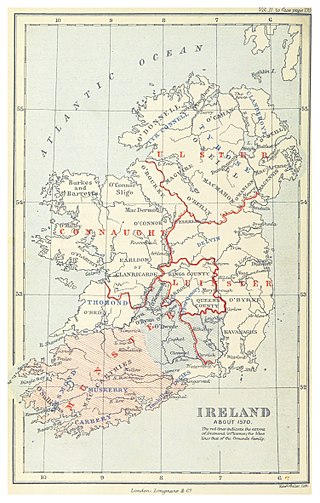
The Desmond Rebellions occurred in 1569–1573 and 1579–1583 in the Irish province of Munster. They were rebellions by the Earl of Desmond, the head of the FitzGerald dynasty in Munster, and his followers, the Geraldines and their allies, against the threat of the extension of the English government over the province. The rebellions were motivated primarily by the desire to maintain the independence of feudal lords from their monarch but also had an element of religious antagonism between Catholic Geraldines and the Protestant English state. They culminated in the destruction of the Desmond dynasty and the plantation or colonisation of Munster with English Protestant settlers. 'Desmond' is the Anglicisation of the Irish Deasmumhain, meaning 'South Munster'.

Gerald FitzGerald, 14th Earl of Desmond, also counted as 15th or 16th, owned large part of the Irish province of Munster. In 1565 he fought the private Battle of Affane against his neighbours, the Butlers. After this, he was for some time detained in the Tower of London. Though the First Desmond Rebellion took place in his absence, he led the Second Desmond Rebellion from 1579 to his death and was therefore called the Rebel Earl. He was attainted in 1582 and went into hiding but was hunted down and killed.
James fitz Maurice FitzGerald, called "fitz Maurice", was a native Irish and Anglo-Norman captain-general of Desmond while Gerald FitzGerald, 14th Earl of Desmond, was detained in England by Queen Elizabeth after the Battle of Affane in 1565. He led the first Desmond Rebellion in 1569 and was sometimes called the "Archtraitor" by the English. He surrendered in 1573, prostrating himself in Kilmallock church before John Perrot, president of Munster.
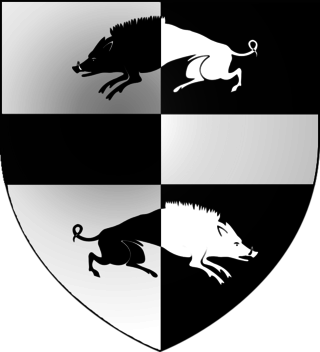
O'Sullivan is an Irish Gaelic clan based most prominently in what is today County Cork and County Kerry. According to traditional genealogy, the O’Sullivans were descended from the ancient Eóganacht Chaisil sept of Cenél Fíngin, the founder of the clan who was placed in the 9th century, eight generations removed from Fíngen mac Áedo Duib, king of Cashel or Munster from 601 to 618. Later, they became the chief princes underneath their close kinsmen, the MacCarthy dynasty, in the small but powerful Kingdom of Desmond, successor of Cashel/Munster. The last independent ruler of the clan was Donal Cam O'Sullivan Beare, who was defeated in the Nine Years' War of 1594–1603.

Castlemaine is a village in County Kerry, Ireland. It lies on the N70 national secondary road between Killorglin and Tralee.
The Second Desmond Rebellion (1579–1583) was the more widespread and bloody of the two Desmond Rebellions in Ireland launched by the FitzGerald Dynasty of Desmond in Munster against English rule. The second rebellion began in July 1579 when James FitzMaurice FitzGerald landed in Ireland with a force of Papal troops, triggering an insurrection across the south of Ireland on the part of the Desmond dynasty, their allies, and others who were dissatisfied for various reasons with English government of the country. The rebellion ended with the 1583 death of Gerald FitzGerald, 14th Earl of Desmond, and the defeat of the rebels.

Maurice FitzGerald, Lord of Maynooth, Naas, and Llanstephan (born: almost certainly not at Windsor Castle, more likely Carew in Wales c.1105 – September c.1176 Wexford, Ireland. He was a medieval Anglo-Norman baron and a major figure in the Norman Invasion of Ireland.
Cormac Laidir MacCarthy, 9th Lord of Muskerry (1411–1494), was an Irish chieftain. He founded Kilcrea Friary and built Kilcrea Castle.

Sir Edward Denny, Knight Banneret, of Bishop's Stortford in Hertfordshire, was a soldier, privateer and adventurer during the reign of Queen Elizabeth I.
Cormac na Haoine MacCarthy Reagh, 13th Prince of Carbery (1490–1567) was an Irish chieftain who owned almost half a million acres in south west Ireland.
Events from the year 1580 in Ireland.

James fitz Maurice FitzGerald, de jure 12th Earl of Desmond, also counted 13th, was called Court Page as he grew up as a hostage for his grandfather Thomas FitzGerald, 11th Earl of Desmond, the Bald, at the court of Henry VIII. He should have succeeded this grandfather in 1534, but John FitzGerald, de facto 12th Earl of Desmond usurped the earldom and was followed in 1536 by his son James, fitz John. In 1539 the lord deputy of Ireland, Leonard Grey seized some Desmond land in southern County Cork and handed it to Court Page, who came to Ireland to claim his rights but was killed by Maurice fitz John FitzGerald, called Totane. He was succeeded by James fitz John, now rightful 13th earl.
Thomas Spring of Castlemaine was an English Protestant soldier, politician and Constable of Castle Maine in County Kerry, Ireland.
Owen O'Moriarty was a Gaelic Irish warrior and chieftain notable for his part in the final stages of the Desmond Rebellion and the death of Gerald FitzGerald, 15th Earl of Desmond in 1583.
The sack of Youghal was the capture of the English-held town of Youghal by Irish rebel forces under the command of the Gerald FitzGerald, the 14th Earl of Desmond on 13 November 1579 as part of the Second Desmond Rebellion. Youghal, a town in the Irish province of Munster, was controlled by the English, making it a target to Irish rebel forces during the rebellion. FitzGerald led an Irish rebel force which captured the city, massacred the English Army garrison, and sacked the town. After news of the sack became known, numerous reprisals were carried out on Catholic non-combatants throughout Ireland.

Cormac Oge Laidir MacCarthy, 10th Lord of Muskerry (1447–1536) was an Irish chieftain, styled Lord of Muskerry. In 1520 he defeated James FitzGerald, 10th Earl of Desmond in the battle of Mourne Abbey.
Sir Thomas Lestrange, also Le Strange, Le Straunge, or Strange, was an English official in the Presidency of Connaught and landowner during the Tudor conquest of Ireland. He was one of the seven sons of Sir Thomas Le Strange of Hunstanton in Norfolk and Anne Vaux, daughter of Nicholas Vaux, 1st Baron Vaux of Harrowden, and like his brothers Nicholas and Richard, the younger Thomas went to Ireland. By 1557 he was sub-constable of Athlone Castle and in 1559 became sheriff of Westmeath. In 1565 he gained two crown leases in County Westmeath: one of 21 years for the lands of the dissolved abbey of Lough Sewdy, the other of 37 years for lands of the attainted Sir Oliver FitzGerald. He used his official positions to acquire lands in counties Galway, Roscommon, and Longford, and at his death owned "30 quarters of land in the territory of Clankerno" [Clann Ceithearnaigh, or Ciarraige Aí]. Lestrange had a castle called Castlereogh near Athleague, in what is now the townland of Castlestrange in the civil parish of Fuerty, County Roscommon.

The Siege of Glin Castle was undertaken between the 5th and 9th of July 1600 by the newly appointed Lord President of Munster, George Carew, in his summer campaign against the followers of James FitzThomas FitzGerald, who had risen up against the English settlers during Tyrone's rebellion and laid claim to the title of Earl of Desmond. Among his allies was Edmund Fitzthomas Fitzgerald, Knight of Glin.

